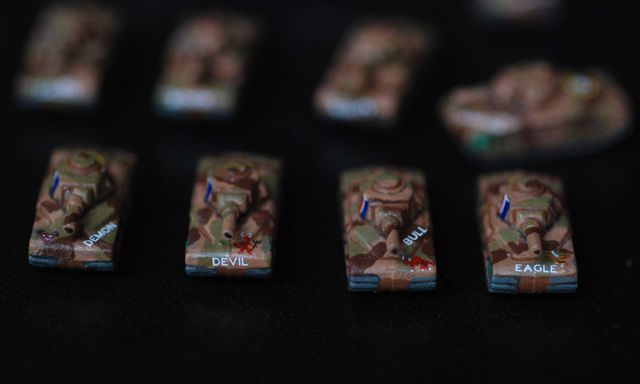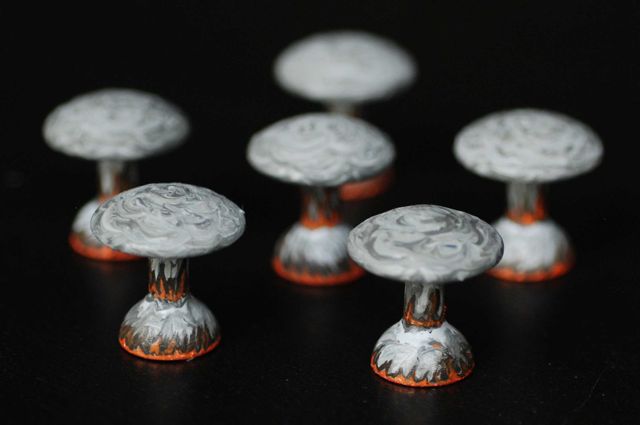Here is the one page of optional rules we use with this AAA50th set, but there is nicely “stylized” reference sheet downloadable here:
http://www.boardgamegeek.com/filepage/69861/expansion-rules
And the broken down tech. chart to use with it, here:
http://www.boardgamegeek.com/filepage/70044/aaa50-expansion-rules-tech-chart
Gears of War:
Players may choose which of the 4 areas from the 2 advancement charts to research by placing their research tokens in the area. Each nation is considered to have a team of researchers factored into their economy, and receive 1 research token at the start of their turn sequence, without allocating funds. All other standard research rules apply.
Shore Guns:
Coastal artillery was largely outmoded during WWII, except in the 5 territories underlined below - where geography still made them viable. Ownership of these units depends upon the ownership of the territory, as they cannot be moved. When passing between the sea zones: 12 &13 (Gibraltar), 15 & 16 (Turkey), 5 & 6 (Norway), 6 & 7 (United Kingdom & Northwestern Europe), all enemy naval units except submarines, must endure 1 cycle of fire from anti-ship guns located in the above territories. Coastal Artillery units attack as anti-aircraft guns, but count as 2 hits to Battleships. A territory successfully taken over by an amphibious assault destroys coastal artillery in the process.
Victory Cities:
Victory Cities can be used for limited unit production/mobilization if owned from the beginning of a turn. A nation owning a Victory City may produce: 1 Infantry per point of the territory value the Victory City is located in (volunteers/routed units), or 1 Transport per point of territory value (merchant marines/civilian ships). Victory City unit production cannot be targeted by strategic bombing, but can be enhanced from the Increased Factory Production and Improved Shipyards developments. Victory city territories with industrial complexes conform to standard rules of production.
China:
“Conscription” (Communist) China is first in the Order of Play, controlled by the Soviet Union until the start of the first U.S. turn, thereafter controlled by the U.S. “Chinese Munitions” If the Burma (road) territory is under Allied control, the U.S may purchase 1 Field Gun unit per turn for the Chinese, if Burma and India is under allied control, the U.K. may also purchase 1 FG per turn for the Chinese. Field Gun units are placed in the purchasing nation’s sequence. A Field Gun unit is treated as a Chinese unit, which is equal to an artillery unit except that it does not confer an artillery/infantry support bonus.
Neutral Territories:
Units may enter a neutral territory or aircraft may land there, but must establish political influence or not be allowed entrance: A nation pays the neutral/bank 3 IPCs the first time of entrance, and places a national marker to show influence. The new cost of influence must exceed the amount of national markers present +3. Influence cannot be established if another nation has units stationed there (though a nation may buy influence if there is no military presence), enemy units must first be removed via Covert Ops (see Elite Infantry) before influence can be established. A nation with the War Bonds development, only pays 3 IPCs to influence, regardless of placed markers. Anytime a land unit enters a neutral territory they must remain there as their final move, though they can be moved into during combat and non-combat turns they may only be exited from during a nation’s non-combat turn. Units cannot conduct attacks from a neutral territory. If a nation chooses to merely violate the neutral airspace, the nation must have influence over the neutral. A nation does not pay the penalty for entering a neutral if they have established influence. Only Elite Units may pass freely into and conduct combat within a neutral (see Elite Infantry: Covert Ops on the reverse page). “The Dardanelles” are the straits linking the Black Sea and the Mediterranean, controlled by neutral Turkey. Naval units (except submarines) must endure a Shore Gun attack (see above) when passing through the straits unless a nation has influence over the neutral territory of Turkey. “Sahara & Himalaya” have no government, and are impassable to all units but bombers and fighters with the Long-Range Aircraft development, which may fly over but not land in the territories.
Air Bases:
A nation with the Radar development may defend allied ships in the island’s sea zone. Islands are any single territories within 1 sea zone (excluding islands with capital cities). Nations with Radar and Long-Range Aircraft may defend territory coastlines/sea zones (including capital city territories).
Atomic Warfare: If a nation has a development in each of the 4 advancement areas, they may dedicate research to nuclear fission as if rolling for an additional development. If the nation succeeds they receive a radiation marker to be placed in a territory they owned (and currently own) at the start of the game, and have the technological development, Atomic Bomb. The bomb is purchased as a unit but must be built in the atomic testing area. 1 A-bomb costs 15 IPC’s. A nation is limited to 1 A-bomb in play (unless salvaged or captured). A nation has 3 methods of attack with an Atomic Bomb: 1. If a nation has the Heavy Bombers development, they may drop the Atomic Bomb as a strategic bombing strike on a territory or sea zone. 2. If a nation has the Rockets development they may launch the A-bomb as per a rocket attack, targeting any territory or sea zone. 3. Super Submarines may launch the A-bomb at any coastal territory that the atomic submarine borders, or a sea zone it enters (retreating after launch). The submarine A-bomb attack is as per a sub sneak attack to be successful (Destroyers prevent the attack).
- The A-Bomb has 3 methods of movement: 1. Carried/delivered by a Heavy Bomber unit. 2. Move/ownership as per an AA Gun. 3. They can move/launch from a Super Submarine. *Note: by method 1 or 3, the bomber or submarine must start in the same territory/adjacent sea zone as the bomb.
- Captured: If an attempt to deliver an Atomic Bomb through method 1 is prevented, the defender rolls a die, a result of 1 means the bomb is salvaged, +1 modifier for each current researcher. If successful, the bomb changes ownership and is placed in the territory that was targeted. A nation that captures an A-bomb does not receive nuclear fission, but may still utilize the bomb if capable of delivering it.
- Blast Site: A successful blast on a territory removes all AA guns, Shore guns, A-bombs, and Industrial Complexes. The nation that dropped the bomb is allowed an attack roll at the strength of 5, against each unit in the territory. The bomb is expended. When a territory suffers an Atomic blast the income value of the territory is halved (rounding up) for the remainder of the game and a mushroom cloud is placed. If an A-Bomb is detonated in a sea zone, all units are subject to an attack at the strength of 4 (territories within sea zones are considered separate targets). Defenders do not receive causality fire vs. an atomic bomb attack. The nation that used the A-Bomb may enter the blast site during non-combat if unoccupied. A “nuked” capital complex resorts to the piece/production ability of a standard victory city.
Elite Infantry: 5 infantry units have an Axis/Allie symbol under each, deployed as needed by the owning player. Whenever a special ability of an Elite Infantry is used, the symbol is revealed. In regard to movement, production, cost, attacking, and defending, the elite units are as infantry. Once an Elite Infantry is chosen as a causality it is removed from the game. Elite Infantry can move through neutral territory but not impassable terrain, incurring no monetary penalty.
- Marines: Highly trained in sea-to-land assaults, Elite Infantry have a +1 combat bonus during the first round of an amphibious assault, accumulative with any artillery bonus.
- Airborne: Elite Infantry are skilled in guerrilla warfare behind enemy lines, a +1 combat bonus during the first round of combat in which they were a paratrooper, accumulative with any artillery bonus.
- Tactical withdrawal: If a nation has Mechanized Infantry, defending Elite Infantry may retreat after the first round of an attack as per the standard rules of retreat, as if they were an attacker.
- Covert Ops.: Elite Infantry entering a neutral with opposing units removes (sabotages) enemy units unless there is defending Elite Infantry. If enemy Elite Infantry are present, covert ops ensues: all Elite Infantry conduct combat: +1 combat bonus if a nation has Advanced Artillery, +1 if a nation has the War Bonds development (espionage/partisan aid). Marines and Airborne bonuses also apply to covert ops. If the attacking Elite Infantry is victorious and survives, the standard enemy units are destroyed.
Interceptors & Escorts: If a nation has Radar, their fighters may intercept and defend against strategic bombing. If a nation has Long-Range Aircraft, their fighters can participate in strategic bombing raids as escorts. Interceptors must originate from the territory being targeted for the strategic bombing. The escorting fighters may protect the bombers, and can originate from any territory, range permitting. Aerial combat is conducted as follows: 1. Escorts and Interceptors fire at “1” for 1 combat round only. 2. Anti-aircraft guns fire at the remaining bombers (not on the fighter-escort). Remove casualties. 3. Surviving bombers may then strategically bomb.
- If fighters have the Jet Power development, they receive a +1 combat modifier in aerial combat.
- If the attacker has Heavy Bombers their bombers may fire at a roll of “1” during aerial combat.
Escorts cannot participate in other battles during the turn of strategic bombing participation.
















